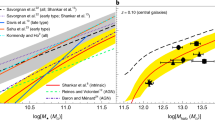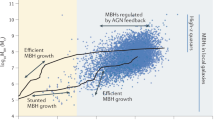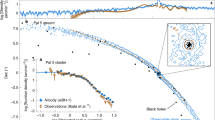Abstract
The early stages of massive black hole growth are poorly understood1. High-luminosity active galactic nuclei at very high redshift2 z further imply rapid growth soon after the Big Bang. Suggested formation mechanisms typically rely on the extreme conditions found in the early Universe (very low metallicity, very high gas or star density). It is therefore plausible that these black hole seeds were formed in dense environments, at least a Hubble time ago (z > 1.8 for a look-back time of tH = 10 Gyr)3. Intermediate-mass black holes (IMBHs) of mass M• ≈ 102−105 solar masses, M⊙, are the long-sought missing link4 between stellar black holes, born of supernovae5, and massive black holes6, tied to galaxy evolution by empirical scaling relations7,8. The relation between black hole mass, M•, and stellar velocity dispersion, σ★, that is observed in the local Universe over more than about three decades in massive black hole mass, correlates M• and σ★ on scales that are well outside the massive black hole’s radius of dynamical influence6, . We show that low-mass black hole seeds that accrete stars from locally dense environments in galaxies following a universal M•/σ★ relation9,10 grow over the age of the Universe to be above (5% lower limit), independent of the unknown seed masses and formation processes. The mass depends weakly on the uncertain formation redshift, and sets a universal minimal mass scale for present-day black holes. This can explain why no IMBHs have yet been found6, and it implies that present-day galaxies with σ★ < ≈ 40 km s–1 lack a central black hole, or formed it only recently. A dearth of IMBHs at low redshifts has observable implications for tidal disruptions11 and gravitational wave mergers12.
This is a preview of subscription content, access via your institution
Access options
Access Nature and 54 other Nature Portfolio journals
Get Nature+, our best-value online-access subscription
$29.99 / 30 days
cancel any time
Subscribe to this journal
Receive 12 digital issues and online access to articles
$119.00 per year
only $9.92 per issue
Buy this article
- Purchase on Springer Link
- Instant access to full article PDF
Prices may be subject to local taxes which are calculated during checkout


Similar content being viewed by others
References
Volonteri, M. The formation and evolution of massive black holes. Science 337, 544–547 (2012).
Mortlock, D. J. et al. A luminous quasar at a redshift of z = 7.085. Nature 474, 616–619 (2011).
Bennett, C. L., Larson, D., Weiland, J. L. & Hinshaw, G. The 1% Concordance Hubble Constant. Astrophys. J. 794, 135 (2014).
Miller, M. C. & Colbert, E. J. M. Intermediate-mass black holes. Int. J. Mod. Phys. D 13, 1–64 (2004).
Abbott, B. P. et al. Observation of gravitational waves from a binary black hole merger. Phys. Rev. Lett. 116, 061102 (2016).
Graham, A. W. in Galactic Bulges (eds Laurikainen, E., Peletier, R. & Gadotti, D. ) 263–313 (Springer, 2016).
Ferrarese, L. & Merritt, D. A fundamental relation between supermassive black holes and their host galaxies. Astrophys. J. 539, L9–L12 (2000).
Gebhardt, K. et al. A relationship between nuclear black hole mass and galaxy velocity dispersion. Astrophys. J. 539, L13–L16 (2000).
McConnell, N. J. & Ma, C.-P. Revisiting the scaling relations of black hole masses and host galaxy properties. Astrophys. J. 764, 184 (2013).
van den Bosch, R. C. E. Unification of the fundamental plane and super massive black hole masses. Astrophys. J. 831, 134 (2016).
Rees, M. J. Tidal disruption of stars by black holes of 106-108 solar masses in nearby galaxies. Nature 333, 523–528 (1988).
Amaro-Seoane, P. et al. eLISA: Astrophysics and cosmology in the millihertz regime. GW Notes 6, 4–110 (2013).
Kormendy, J. & Ho, L. C. Coevolution (or not) of supermassive black holes and host galaxies. Annu. Rev. Astron. Astrophys. 51, 511–653 (2013).
Shen, Y. et al. The Sloan Digital Sky Survey Reverberation Mapping project: no evidence for evolution in the M•−σ* relation to z ~ 1. Astrophys. J. 805, 96 (2015).
Alexander, T. in The Galactic Center: A Window to the Nuclear Environment of Disk Galaxies (eds Morris, M. R., Wang, Q. D. & Yuan, F. ) ASP Conf. Ser. Vol. 439, 129–141 (ASP, 2011).
Bar-Or, B. & Alexander, T. Steady-state relativistic stellar dynamics around a massive black hole. Astrophys. J. 820, 129 (2016).
Magorrian, J. & Tremaine, S. Rates of tidal disruption of stars by massive central black holes. Mon. Not. R. Astron. Soc. 309, 447–460 (1999).
Merritt, D. Dynamics and Evolution of Galactic Nuclei (Princeton Univ. Press, 2013).
Stone, N. C., Küpper, A. H. W. & Ostriker, J. P. Formation of massive black holes in galactic nuclei: runaway tidal encounters. Mon. Not. R. Astron. Soc. 467, 4180–4199 (2017).
Ayal, S., Livio, M. & Piran, T. Tidal disruption of a solar-type star by a supermassive black hole. Astrophys. J. 545, 772–780 (2000).
Bar-Or, B., Kupi, G. & Alexander, T. Stellar energy relaxation around a massive black hole. Astrophys. J. 764, 52 (2013).
Xiao, T. et al. Exploring the low-mass end of the MBH–σ* relation with active galaxies. Astrophys. J. 739, 28 (2011).
Salviander, S. & Shields, G. A. The black hole mass-stellar velocity dispersion relationship for quasars in the Sloan Digital Sky Survey Data Release 7. Astrophys. J. 764, 80 (2013).
Sijacki, D. et al. The Illustris simulation: the evolving population of black holes across cosmic time. Mon. Not. R. Astron. Soc. 452, 575–596 (2015).
Taylor, P. & Kobayashi, C. Time evolution of galaxy scaling relations in cosmological simulations. Mon. Not. R. Astron. Soc. 463, 2465–2479 (2016).
Chen, X., Sesana, A., Madau, P. & Liu, F. K. Tidal stellar disruptions by massive black hole pairs. II. Decaying binaries. Astrophys. J. 729, 13 (2011).
Walker, M. G. et al. A universal mass profile for dwarf spheroidal galaxies? Astrophys. J. 704, 1274–1287 (2009).
Baldassare, V. F., Reines, A. E., Gallo, E. & Greene, J. E. A ~50,000M⊙ solar mass black hole in the nucleus of RGG 118. Astrophys. J. 809, L14 (2015).
Kzltan, B., Baumgardt, H. & Loeb, A. An intermediate-mass black hole in the centre of the globular cluster 47 Tucanae. Nature 542, 203–205 (2017).
Dubois, Y. et al. Black hole evolution: I. Supernova-regulated black hole growth. Mon. Not. R. Astron. Soc. 452, 1502–1518 (2015).
Fialkov, A. & Loeb, A. Jetted tidal disruptions of stars as a flag of intermediate mass black holes at high redshifts. Available at http://arXiv.org/abs/1611.01386 (2016).
Rosswog, S., Ramirez-Ruiz, E. & Hix, W. R. Tidal disruption and ignition of white dwarfs by moderately massive black holes. Astrophys. J. 695, 404–419 (2009).
Stone, N. C. & Metzger, B. D. Rates of stellar tidal disruption as probes of the supermassive black hole mass function. Mon. Not. R. Astron. Soc. 455, 859–883 (2016).
Yagi, K. Scientific potential of DECIGO Pathfinder and testing GR with space-borne gravitational wave interferometers. Int. J. Mod. Phys. D 22, 1341013 (2013).
Bahcall, J. N. & Wolf, R. A. Star distribution around a massive black hole in a globular cluster. Astrophys. J. 209, 214–232 (1976).
Lightman, A. P. & Shapiro, S. L. The distribution and consumption rate of stars around a massive, collapsed object. Astrophys. J. 211, 244–262 (1977).
Hoyle, F. & Lyttleton, R. A. The effect of interstellar matter on climatic variation. Proc. Camb. Phil. Soc. 35, 405 (1939).
Bondi, H. On spherically symmetrical accretion. Mon. Not. R. Astron. Soc. 112, 195 (1952).
Alexander, T. & Natarajan, P. Rapid growth of seed black holes in the early Universe by supra-exponential accretion. Science 345, 1330–1333 (2014).
Murphy, B. W., Cohn, H. N. & Durisen, R. H. Dynamical and luminosity evolution of active galactic nuclei: models with a mass spectrum. Astrophys. J. 370, 60–77 (1991).
Freitag, M. & Benz, W. A new Monte Carlo code for star cluster simulations. II. Central black hole and stellar collisions. Astron. Astrophys. 394, 345–374 (2002).
Tremaine, S. et al. The slope of the black hole mass versus velocity dispersion correlation. Astrophys. J. 574, 740–753 (2002).
Syer, D. & Ulmer, A. Tidal disruption rates of stars in observed galaxies. Mon. Not. R. Astron. Soc. 306, 35–42 (1999).
Acknowledgements
We are grateful for discussions with Y. Alexander, J. Gair, A. Gal-Yam, J. Green, J. Guillochon, M. MacLeod, N. Neumayer, T. Piran, E. Rossi, A. Sesana, J. Silk, N. Stone and B. Trakhtenbrot. T.A. acknowledges support from the I-CORE Program of the Planning and Budgeting Committee and The Israel Science Foundation (Grant No. 1829/12). B.B.-O. acknowledges support from NASA (grant NNX14AM24G) and the NSF (Grant AST-1406166).
Author information
Authors and Affiliations
Contributions
T.A. and B.B.-O. developed the ideas presented in this paper together and collaborated in its writing.
Corresponding authors
Ethics declarations
Competing interests
The authors declare no competing financial interests.
Rights and permissions
About this article
Cite this article
Alexander, T., Bar-Or, B. A universal minimal mass scale for present-day central black holes. Nat Astron 1, 0147 (2017). https://doi.org/10.1038/s41550-017-0147
Received:
Accepted:
Published:
DOI: https://doi.org/10.1038/s41550-017-0147
This article is cited by
-
Astrophysics with the Laser Interferometer Space Antenna
Living Reviews in Relativity (2023)
-
Tidally disrupted stars as a possible origin of both cosmic rays and neutrinos at the highest energies
Scientific Reports (2018)



